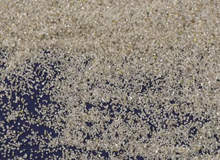
BP recently announced a ‘giant’ oil discovery in the Gulf of Mexico in the deepest well ever drilled. The Tiber fields hold at least three billion barrels of oil, of which only 500 million is recoverable with today’s technology. The news caused the value of BP to jump £4bn on 2 September and came just a week after Iran announced it had discovered a further 8.8 billion barrels’ worth of crude oil at the Sousangerd field in the Khouzesrtan province.
These discoveries point to the fact that although the number of new discoveries is dwindling, the potential to find untapped oil may be greater than many thought. What is clear is that these finds are likely to be in harder-to-reach places and need cutting-edge technology to make them financially viable.
Over the past century, diamond drill bits have proved their worth and today remain a leading technology. Diamond drill bits were first used to drill for oil in 1863 and today, the sector has evolved into a technologically advanced and very profitable industry. The dynamics of superior performance, lower cost-per-foot and the drive for an increased rate of penetration are now more important than ever as oil prices remain far from their record highs.
Diamond drill bits are well known in the mining industry and although the basic technology may look the same, polycrystalline diamond compact (PDC) technology is specifically designed for drilling oil and gas wells. As easy-to-reach oil is becoming increasingly elusive, equipment that is effective, reliable and cost sensitive is in ever-greater demand.
Diamond drill bit manufacturing giant Baker Hughes’s investor relations assistant director Gene Shiels says that PDC bits have become so advanced that their designs are now specialised to address different formations and to minimise vibration, which can lead to premature wear and slow the drilling process.
“Today there is a significant focus on drilling optimisation which is the process of looking at bit design, drilling fluids and bottom-hole assembly in concert with each other to improve drilling performance on the basis of a system as opposed to individual components,” Shiels says.
Evolving technology
The biggest technological developments have been in the improvements in PDC cutter design. “This has significantly improved the life of PDC cutters and therefore the life of the bit,” Shiels says. “Whereas the industry used to talk about how many bits it would take to drill a well, today we often talk about how many wells we can drill with a PDC bit.”
The type of formation of the drill dictates the bit type and design. While tri-cone bits work by chiselling the formation, PDC drills work by scraping the surface. But because of technological advances in the PDC arena, these bits are now being used in many areas that the more-traditional tri-cone technology previously dominated.
Today, many wells use a combination of tri-cone and PDC technology. And, because each piece uses a standard thread design it is very easy to integrate technology from a variety of suppliers. Also driving demand is the increased use of steerable systems to drill deviated and horizontal wellbores.
The fact that diamond bits now have a longer lifespan means that the dynamics of the industry are changing dramatically. In the North American sector in particular, this is giving rise to a new rental market. “We benefit as the margins for rental bits are attractive and the customer gains in that he is not paying full price for the bit,” Shiels says. “Instead, he is essentially paying for the ‘feet of hole’ he needs.”
Counting the cost
PDC bits are nothing new to the offshore industry, but the applications that they can now be used for and their increased lifespan may be. As crude oil prices remain around the $70-a-barrel mark, offshore explorers are still counting every penny and the cost of equipment is keenly felt.
Shiels admits that PDC equipment will cost more than tri-cone bits and says this is because the manufacturing process is completely different.
A tri-cone bit consists of a head section that has three rotating cones mounted on three bearing assemblies that rotate in turn. They are made by a refined machining process where components are heat treated and assembled.
PDC bits are, by contrast, made by hand though a casting process where a graphite ‘reverse mould’ is constructed. “The mould is then filled with a special matrix material in combination with a binding agent and heated so that the binding agent permeates the matrix, forming the bit,” Shiels says. The only way the task can be completed is by breaking the cast, adding to the cost of the manufacturing process.
Saving money can be achieved, according to Shiels, by altering an original bit design for a secondary purpose. “In fact, in some extended drilling programmes, bits are actually redesigned to improve performance,” he says. So with costs able to be controlled and the longer lifespan of the bit meaning that it can be used on more and more wells, investing in diamond drilling may well be in the interests of offshore explorers keen to hit their pot of gold.



